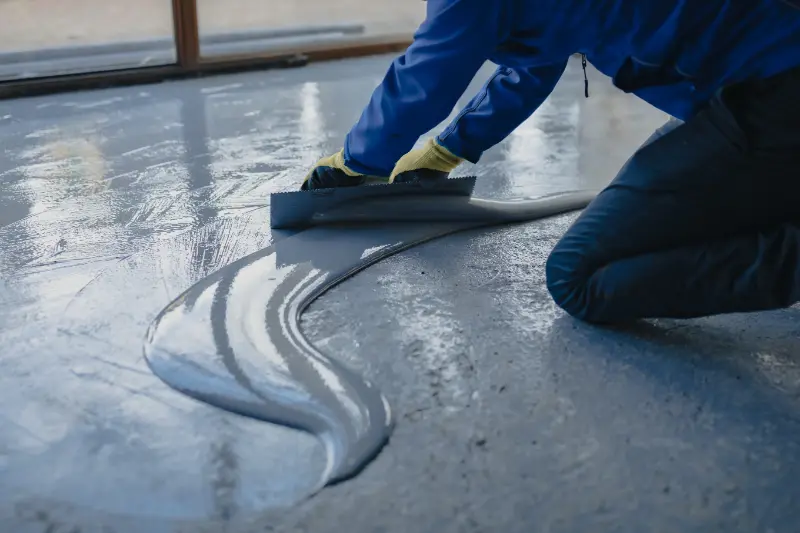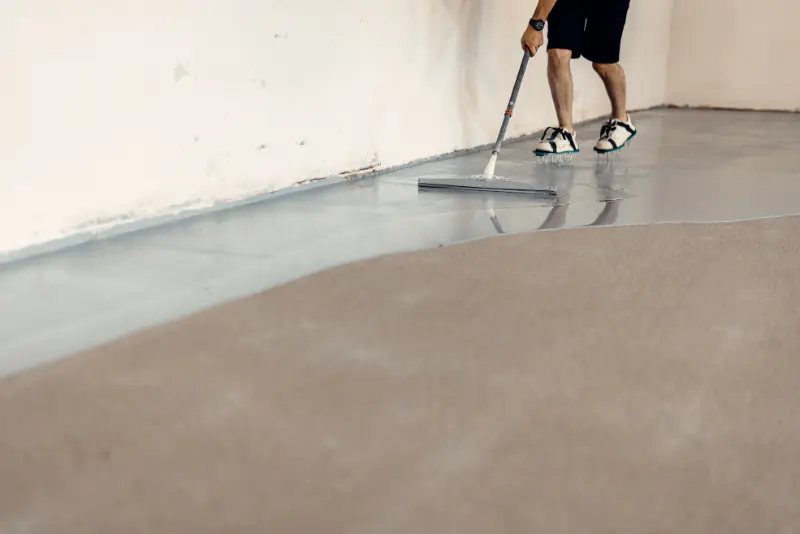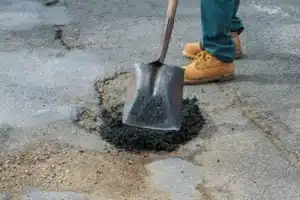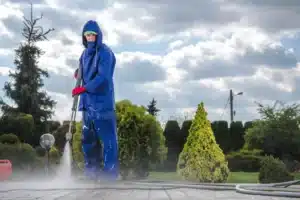Concrete surfaces are popular and durable but require maintenance to keep them looking their best. Sealing is an effective way to protect concrete from the elements and wear, but the waiting period after sealing is just as important. Walking on the surface too soon can damage the seal and compromise the effectiveness of the treatment. In this article, we will discuss the critical waiting period after sealing concrete and provide concrete wisdom that will ensure the longevity of your surface. We encourage you to read the article in its entirety to gain a complete understanding of this important post-sealant period.
What is the Importance of Sealing Your Concrete Driveway
Sealing a concrete driveway is critical in ensuring its longevity and overall maintenance. By acting as a barrier, sealers prevent moisture infiltration, resist stains, and combat weathering. However, it is important to note that not all sealers are created equal. Different formulations have been specifically designed for particular environments and concrete conditions, and the type of sealer selected will dictate not only the level of protection provided but also the duration of time that must elapse before normal footfall traffic may resume. Therefore, careful consideration and selection of a suitable sealer are essential in ensuring optimal performance, durability, and protection of a concrete driveway.

How to Choose The Right Concrete Sealer For Your Driveway
Choosing the right concrete sealer for your driveway involves considering several factors to ensure durability, aesthetic appeal, and protection against various elements. Here are some tips to help you make an informed decision:
- Assess the Current Condition of Your Driveway: Before selecting a sealer, examine the condition of your driveway. Look for cracks, discoloration, or previous sealant layers. The sealer you choose should be appropriate for the current state of the concrete.
- Determine the Primary Purpose of the Sealer: Sealers can serve different purposes:
- Protection: Against stains, weather, UV rays, and chemicals.
- Aesthetics: Enhancing the color or providing a glossy, matte, or wet look.
- Performance: Increasing durability or slip resistance.
- Choose the Type of Sealer:
- Acrylic Sealers: Ideal for moderate weather conditions, offering good protection and enhancing the concrete’s appearance. They’re easy to apply and relatively affordable.
- Epoxy or Urethane Sealers: More durable and suitable for high-traffic areas. They provide strong protection against chemicals and abrasions but can be more expensive and complex to apply.
- Penetrating Sealers: Excellent for protecting against moisture and de-icing salts, ideal for harsh weather conditions. They don’t change the appearance of the concrete and are long-lasting.
- Consider the Finish: Sealers can provide glossy, matte, or natural finishes. Glossy sealers can enhance color but may be slippery when wet. Matte finishes provide a more natural look.
- Check Compatibility with Existing Sealers: If your driveway has been previously sealed, ensure the new sealer is compatible with the old one. Some sealers can’t be applied over others.
- Ease of Application and Maintenance: Consider how easy the sealer is to apply and maintain. Some require a professional application, while others can be DIY projects.
- Cost and Longevity: Balance the cost of the sealer with its expected lifespan. Higher upfront costs might be justified by longer-lasting protection. Following these, you can choose a concrete sealer that will effectively protect and enhance your driveway for years to come.

So, How Long After Sealing Concrete Can You Walk On It?
After sealing concrete, waiting before you can walk on it is important. Typically, you should wait about four to five hours post-application for the surface to dry enough to handle foot traffic. However, it’s essential to note that this is surface dryness, and full curing could take up to three days. During this time, heavy loads and parking should be avoided as they could compromise the sealer’s effectiveness. Doing so will allow the sealer to achieve its full potency state, which is necessary for long-lasting protection.
Drying Time for Different Sealer Types
Acrylic Sealers
Acrylic sealers typically dry to the touch within 1-4 hours, but waiting about 24-48 hours is recommended before allowing vehicle traffic. Environmental conditions can influence the drying time; higher temperatures and lower humidity can speed up the process, while cooler temperatures and higher humidity may prolong it.
Epoxy and Urethane Sealers
Epoxy and urethane sealers have a longer drying time than acrylics, often taking 10-12 hours to dry to the touch and 24-72 hours before being ready for heavy traffic. These sealers are sensitive to temperature and humidity, and proper ventilation is crucial for faster curing.
Penetrating Sealers
Penetrating sealers generally dry within 2-4 hours to the touch, but it’s advisable to wait about 24-48 hours for complete curing. The drying time for these sealers is also affected by environmental conditions, with warm, dry conditions aiding in faster drying.
Polyaspartic Sealers
Polyaspartic sealers are known for their rapid curing time, often drying to the touch in 1-2 hours and fully curing in about 5-12 hours. They cure quickly even in cooler temperatures, but heat and low humidity can further accelerate the drying process.
Remember to always refer to the manufacturer’s instructions for the specific drying times of your product, as formulations can vary.
The Impact of Weather Conditions on Concrete Sealing
Weather conditions can have a significant impact on the effectiveness of concrete sealing. For instance, high humidity can cause quick-drying sealants to take longer to dry, while sunlight can speed up the process. Given the unpredictability of weather, it is advisable to rely on the expertise of local contractors such as Matt The Driveway Guy to navigate these meteorological nuances.
Applying Your Concrete Sealer: Techniques for Success
Achieving a successful seal on your concrete involves a blend of uniform application, accurate coverage, and the appropriate tools—key elements in the narrative of sealing success. Cutting corners in any of these aspects can significantly undermine the effectiveness and durability of your sealant, a risk no homeowner should take with their driveway or any concrete surface. It’s crucial to pay meticulous attention to each step in the sealing process to ensure a lasting and protective finish on your concrete installation.
7 Common Sealing Mistakes
When applying a concrete sealer, avoiding common mistakes is essential to ensure the longevity and effectiveness of the seal. Here are some of the frequent missteps to avoid:
- Inadequate Surface Preparation: Not properly cleaning or repairing the concrete surface before sealing can lead to poor adhesion and uneven coverage. Ensure the surface is free of dirt, grease, and existing sealants or coatings.
- Applying in Unsuitable Weather Conditions: Sealing in extreme temperatures, high humidity, or wet weather can negatively affect the curing process and the final outcome. Always check weather forecasts and follow manufacturer guidelines for optimal application conditions.
- Incorrect Sealer Type for the Concrete: Using the wrong type of sealer for your specific concrete type or the conditions it’s exposed to can lead to premature wear or inadequate protection. Match the sealer to the concrete’s use, environment, and desired aesthetic.
- Over or Under Application: Applying too much sealer can lead to a sticky, cloudy, or slippery surface, while too little won’t provide adequate protection. Follow the manufacturer’s recommended application rates for the best results.
- Neglecting to Test the Sealer: Not testing the sealer on a small, inconspicuous area can lead to unexpected results or dissatisfaction with the appearance. Always perform a patch test first.
- Poor Application Technique: Uneven application or failing to maintain a wet edge can result in streaks, bubbles, or lap lines. Use the right tools and techniques for a smooth, uniform finish.
- Ignoring the Curing Time: Using the sealed area too soon can damage the seal. Respect the sealer’s curing time, as the manufacturer indicates, to ensure full protection and durability.
Professional Guarantee A Perfect Job
Choosing professionals to apply concrete sealer brings together their expertise and experience with specialized application techniques, ensuring the best choice of sealer for different concrete types and conditions. This expertise is critical for unique or challenging surfaces, where specialized knowledge can make a significant difference. Additionally, the quality of the application is greatly enhanced by professionals who use specialized tools and methods, ensuring a uniform, flawless finish and avoiding common issues like streaks or uneven coverage. Their skill in proper surface preparation, crucial for optimal sealer adhesion and longevity, further underscores the value of professional services, resulting in a durable, aesthetically pleasing, and well-protected concrete surface. Request a quote today from Matt, the Driveway Guy, for the best service.
Final Thoughts
Embracing the necessary waiting periods enables each sealer to bond, protect, and fulfill its purpose effectively. Matt The Driveway Guy stands as your reliable expert in concrete preservation, bringing a wealth of experience for a perfect and fully satisfactory job at all times. Remember, your driveway is more than just a surface; it’s a testament to enduring craftsmanship. As you deliberate over the choice of sealers, drying times, and appropriate usage periods, let the wisdom of patience and the expertise of professionals illuminate your path.






